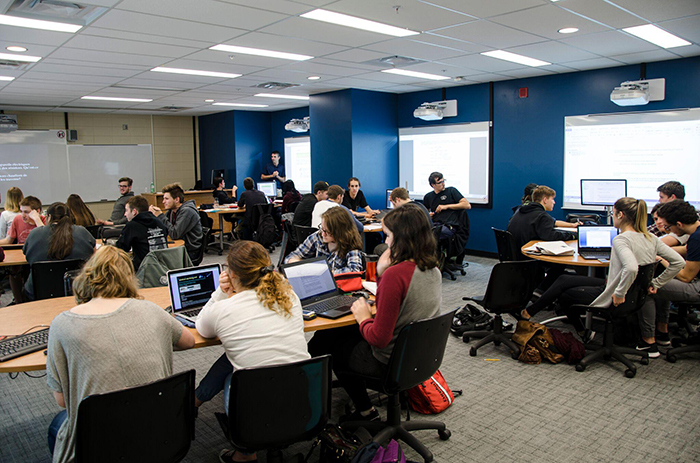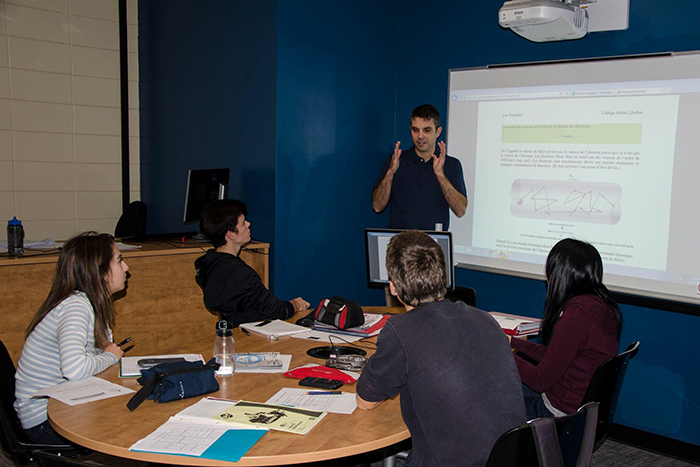Problem-Based Learning Combined with Active Learning in Physics
Friday September 30, 2016, I had the opportunity to attend a physics course based on Problem-Based Learning (PBL) in a multifunctional classroom. I was also able to speak with Stéphan Gaumont-Guay, a teacher at Cégep Limoilou who has been using this approach since 2004. Our meeting place was in a 21st century classroom at the Charlesbourg Campus.
21st Century Classroom
This adventure initially started with a pilot project, the only means for Stéphan to try PBL in 2004. The classroom layout possibilities and the available resources were very different from what we have today.
For awhile, I had to bring extension cords as well as power bars with surge protection in order to persuade my students to bring their laptops to class. I wanted each team to have at least one. Now, I encourage my students to bring and use their cellphones in class!
In 2012, after several years of putting PBL into practise and using ICTs in his courses, Stéphan was invited to present the Active Learning Classroom to the Direction of Studies Committee. It was following this consultation that the project of the 21st Century classroom took shape. The main characteristics retained for the development of the class are: tables equipped with a computer as well as an interactive projector that can accommodate several students and their laptop computers.
The first classroom emerged in 2012 at the Quebec Campus. Another classroom was built afterward at the Charlesbourg Campus in fall 2014.

The configuration of the classroom at the Charlesbourg Campus.
PBL Explained
According to Ouellet and Guilbert (1997), Problem-Based Learning (PBL) is defined as:
A process of solving a complex problem where participants, grouped into teams, work together to look for information and to solve a real or realistic problems proposed in a way that develops competencies of problem solving and while learning content at the same time.
This approach is based on:
- Teamwork
- Discussions
- Peer learning
Students are placed in the heart of the learning process, being active in the construction of their knowledge. The teacher is a guide rather than an all-knowing professor.
It is an approach based on radical constructivism. I place my students in front of a complex and realistic problem in order for them to collaborate and rally together in order to find a potential solution. There is no longer the question of transmitting knowledge to students, but of constructing knowledge. This approach attempts to make the students autonomous in their learning. One of the particularities of PBL is to propose a problem to students in a real situation, which allows them to contextualise and make sense of the different concepts as well as the proposed methodology.
PBL adheres well to the competency based approach established in the Quebec college network for approximately 10 years by the Ministry of Education (previously the MELS). In the Natural Sciences program, it allows different objectives to be met, such as:
- Apply a scientific method
- Use appropriate technologies for the handling of information
- Communicate in a clear and precise manner
- Learn in an autonomous way
- Work in a team
- Deal with new situations starting from acquired knowledge
The 5 Steps of Problem-Based Learning

The 5 steps of Problem-Based Learning
- Students are brought to define the context and the problem as precisely as possible. Each team could identify the problem in a different way!
- Students must search in their baggage for knowledge and past experiences that could be useful in the context of the problem. They can also create a list of solutions or hypotheses to verify.
- Students must identify the “black boxes”. These are unknown elements and terms that deserve to be examined in depth. They could touch different disciplines, as this reaches one of the objectives of PBL.
- This is the longest step and it requires the most research for students. Opening up a “black boxes” can be done in different ways:
- Readings from a book or internet site
- Laboratory experiment
- Test in a real situation
- Discussion with a teacher or a resource person, etc.
It is important to then identify sources of information and summarize what has been learned.
- It is at this moment that students make connections between all the information they have collected in order to propose a solution, if one exists. It is the ideal moment to propose a continuation to the problem and to become aware of the interdisciplinary nature of a real problem.
You can read more about the black box concept, developed first by engineers and adapted for education by Gerard Fourez on PISTES website. Or by consulting a report on Stéphan’s experiences. Documents available in French only.
Problem-Based Learning Combined with the Active Classroom, A Winning Duo!
With PBL, you have to make sure students are equipped and have access to different resources during their research. The 21st Century Classroom lends itself well to this exercise: it allows students to make connections between science, technology and society. Computers facilitate researching information: articles, videos, diverse applications.
According to Stéphan, even if all of these learning tools have enormous potential, they can also amount to nothing as they can be a great source of distraction for students. The teacher must supervise the students adequately in order to make proper use of the resources.

Students researching answers to one of the PBL questions.
Finished with “What Is the Point of This?”
During the first class of the semester, Stéphan presents how PBL functions as well as the objectives of this approach. Right from the beginning, students realize that this course will be different from others. He observes 3 types of reactions from the students:
- Those who show a great interest
- Those who become more worried or more unstable
- Those who hold on to the traditional approach
As the saying goes: “seeing is believing”. After the first experience with this new approach, students are generally motivated to continue.
At the mid-term, he changes the teams, which were initially created without restrictions, in order to break up the routine that gets established. This creates a new dynamic which gives a second wind to some students.
Formative evaluations can be conducted when students are in working groups. It is possible to question their methodology as a way to get them to push their thinking further or to redirect them if they digress in their research. However, the greater the number of groups there are, the more difficult it is to provide individual feedback to students.
For summative exam preparation, Stéphan identifies typical exercises to carry out that are related to the different concepts addressed. His written exams are made up of the most important part of the summative evaluation. There are long answer questions in mathematics that are similar to the suggested exercises, as well as questions about the comprehension of concepts without any calculations. Stéphan explains that his exams have not changed with PBL. He comes to the same evaluation objectives as his colleagues in physics, by taking a different road to get there.
Nevertheless, Stéphan notices that learning within a context makes for better retention and a better transfer of knowledge, as he can bring together several related concepts under the same theme rather than one after the other, in a succession. For example, he uses the diagram of concepts as a summative evaluation at the end of one PBL. Individually, the students build a diagram of concepts with the help of PowerPoint, which brings them to summarize and to create links between different notions seen in PBL. This particularly allows them to recapitulate and structure their learning.

A formative evaluation in action!
Stéphan wishes to develop one full semester based on only one problem or even around one situation broad enough to associate each team with a different facet:
- In the first case, it would allow him to attach all of the concepts to a real context. He worries however about “losing” some students that would not be interested in the chosen theme.
- In the second case, he could count on “teams of experts” in the goal of creating new groups of students made up from the different teams, each bringing their different vision to the same problem. This would allow him to go further with the approach that he already uses in class. However, the chosen subject must be extensive enough to be studied from different angles.
For the moment, he is thinking once again about the way in which to implement these projects.
Over the years, Stéphan has shared his problems with physics teachers from different CEGEPs. It is thanks to these exchanges that he has enhanced and improved his activities.
Would you like to share your course experiences in PBL? Would you like to share your ideas and suggestions? Don’t hesitate to write them down in the comments section below or directly to Stéphan.
Useful References
- The World-wide Impact of Problem-based Learning, by Nathaniel Lasry.
- A Problem-based Learning Approach in a Virtual Environment, by Philippe Gagné
- Netvibes: A Tool to Focus Attention during Inquiry -based Learning, by Silvia d’Appollonia
- GUILBERT, L. and L.OUELLET. Études de cas: Apprentissage par problèmes. Sainte-Foy, Presses de l’université du Québec, 1997, 136p.
- Report on Stéphan’s experience.
- Consult the PBL experience of another teacher from Cégep Limoilou: Une salle de formation documentaire inspirée de la classe d’apprentissage actif.
- Un premier cours gratuit en ligne (CLOM) à l’Université de Sherbrooke in spring 2017 about PBL.

